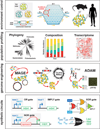Engineering ecosystems and synthetic ecologies
- PMID: 22722235
- PMCID: PMC3430802
- DOI: 10.1039/c2mb25133g
Engineering ecosystems and synthetic ecologies
Abstract
Microbial ecosystems play an important role in nature. Engineering these systems for industrial, medical, or biotechnological purposes are important pursuits for synthetic biologists and biological engineers moving forward. Here we provide a review of recent progress in engineering natural and synthetic microbial ecosystems. We highlight important forward engineering design principles, theoretical and quantitative models, new experimental and manipulation tools, and possible applications of microbial ecosystem engineering. We argue that simply engineering individual microbes will lead to fragile homogenous populations that are difficult to sustain, especially in highly heterogeneous and unpredictable environments. Instead, engineered microbial ecosystems are likely to be more robust and able to achieve complex tasks at the spatial and temporal resolution needed for truly programmable biology.
Figures





References
Publication types
MeSH terms
Grants and funding
LinkOut - more resources
Full Text Sources

